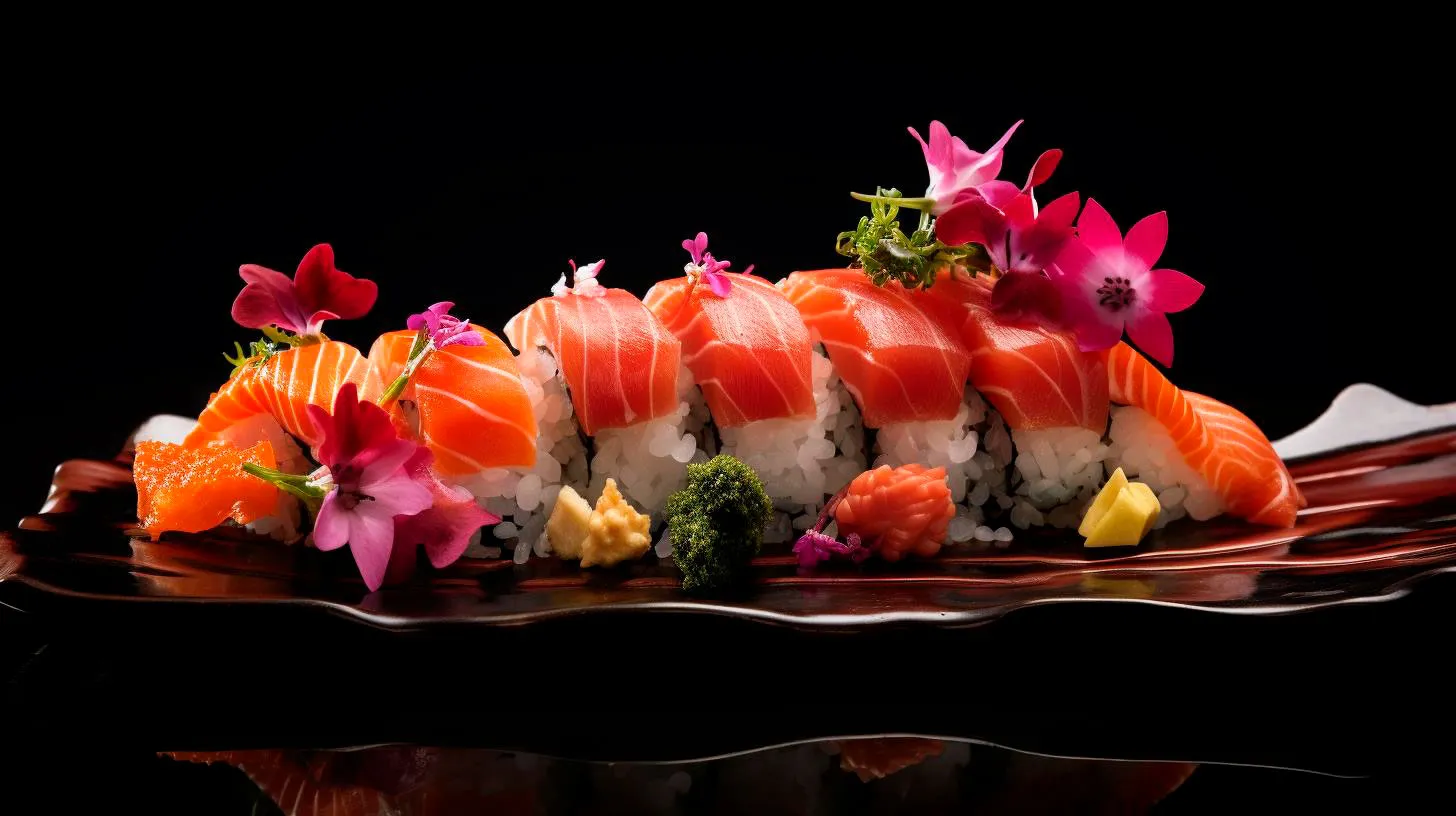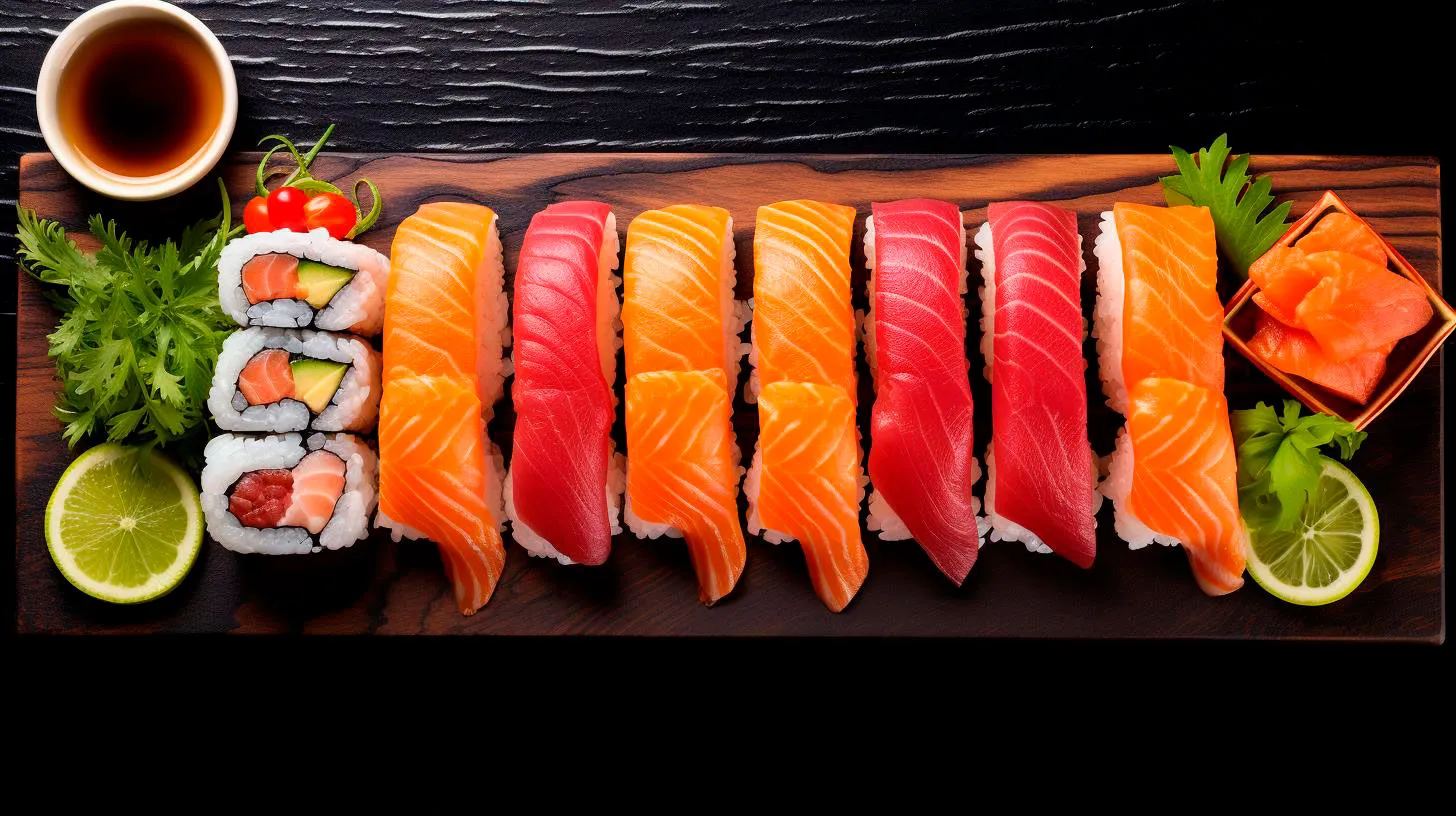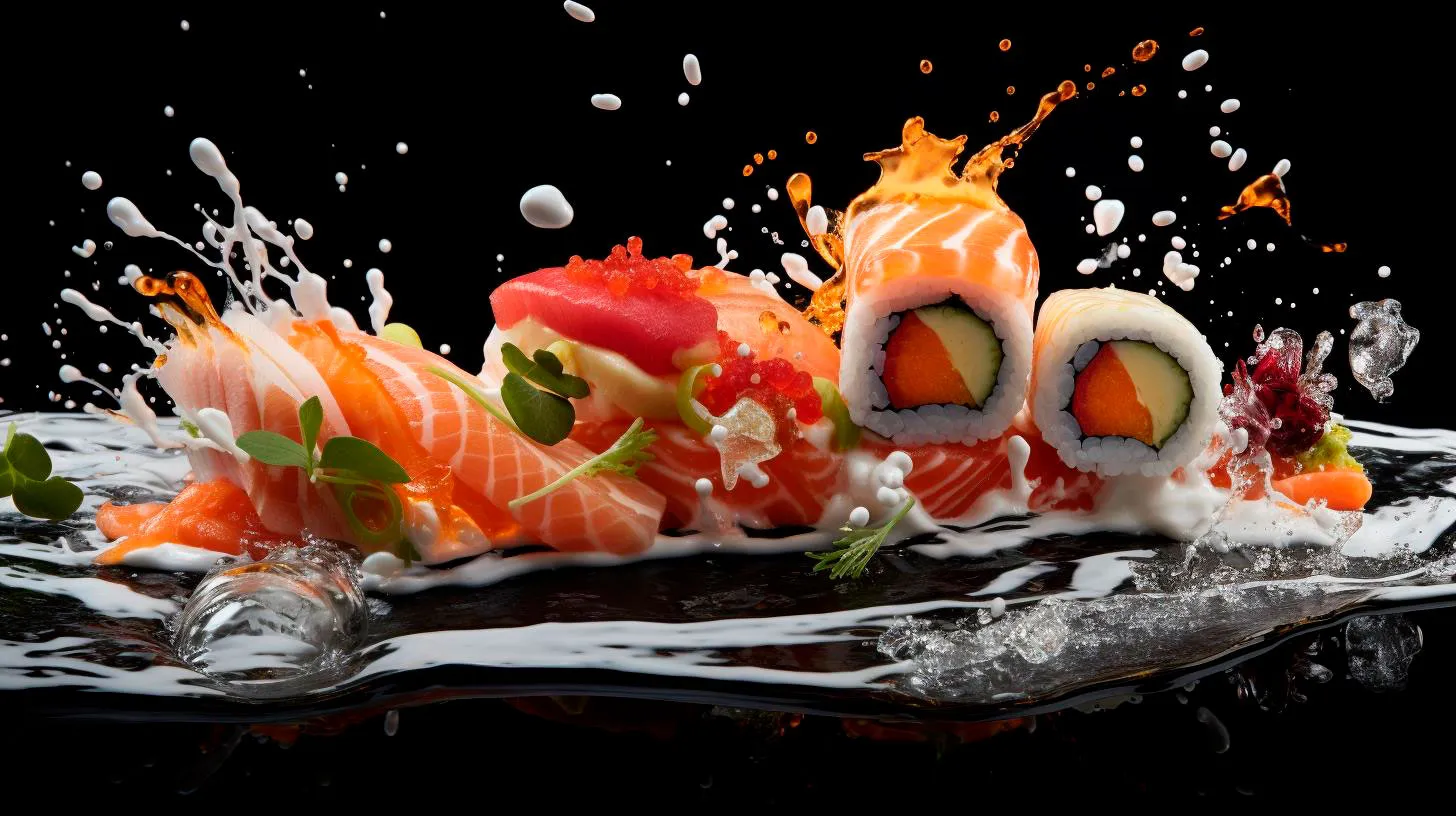Discovering the Paleo Way: Enjoying Sushi while Staying Grain-Free
Thankfully, there are ways to enjoy sushi while staying true to the Paleo way. In this article, we will explore the art of Paleo sushi and discover how you can indulge in this Japanese delicacy without compromising your dietary choices.
Understanding the Paleo Diet
Before we delve into the world of Paleo sushi, let’s take a quick look at what the Paleo diet entails. The Paleo diet, also known as the Caveman diet, is based on the idea of consuming foods that our ancient ancestors thrived on during the Paleolithic era. This means eliminating processed foods, grains, legumes, dairy, and refined sugars, and focusing on whole, unprocessed foods such as lean meats, fish, vegetables, fruits, nuts, and seeds.
The Paleo diet not only promotes weight loss but also enhances overall health by reducing inflammation, improving digestion, and increasing energy levels. With these benefits in mind, it’s no wonder that many individuals have adopted this way of eating.
Introducing Paleo Sushi
Sushi, a traditional Japanese dish, typically consists of vinegared rice, various fillings such as fresh seafood or vegetables, and is often accompanied by soy sauce and wasabi. While rice is a staple ingredient in sushi, it is not considered Paleo-friendly due to its high carbohydrate content. However, that doesn’t mean you have to bid farewell to sushi altogether.
Paleo sushi offers a creative twist on this well-loved cuisine by replacing rice with alternative grain-free options. Let’s dive into some innovative Paleo sushi ideas that will satisfy your cravings while keeping you on track with your grain-free lifestyle:
1. Cauliflower Rice Sushi
One of the most popular substitutes for traditional sushi rice is cauliflower rice. Prepared by pulsing cauliflower florets in a food processor, cauliflower rice mimics the texture and appearance of rice. It is a low-carb and nutrient-dense alternative that pairs perfectly with sushi fillings. You can find pre-made cauliflower rice in many grocery stores, or easily make it at home with a fresh head of cauliflower.
Key Takeaway: Cauliflower rice is a versatile, grain-free substitute that allows you to enjoy sushi while following the Paleo diet. Remember to properly season your cauliflower rice with vinegar, salt, and other traditional sushi seasonings for an authentic flavor.
2. Nori Wraps
Another way to enjoy Paleo sushi is by using nori wraps, which are dried seaweed sheets commonly used to wrap sushi rolls. Nori wraps are naturally gluten-free and low in calories. Fill them with your favorite Paleo-friendly ingredients such as fresh fish, seafood, avocado, cucumber, and sliced vegetables for a satisfying and nutritious meal.
Key Takeaway: Nori wraps are an excellent alternative to traditional rice-based sushi rolls when following the Paleo diet. Experiment with different fillings and create your own unique sushi combinations.
3. Lettuce Wraps
For those who prefer a lighter option or want to add an extra crunch to their sushi, lettuce wraps can be an ideal choice. Use large lettuce leaves, such as romaine or butter lettuce, as a wrap and stuff them with your desired fillings. The crispness of the lettuce will provide a refreshing contrast to the savory fillings.
Key Takeaway: Lettuce wraps offer a refreshing and low-calorie option for Paleo sushi. They are perfect for those who prefer a lighter and gluten-free alternative to traditional sushi rolls.
Benefits of Paleo Sushi
Now that we’ve explored the creative options for Paleo sushi, let’s discuss some of the benefits you can reap from enjoying this grain-free delicacy:
- Grain-Free Goodness: By substituting grains with alternatives like cauliflower rice or lettuce wraps, you can maintain your commitment to a grain-free diet without sacrificing flavor or satisfaction.
- Rich in Nutrients: Paleo sushi emphasizes fresh, nutrient-dense ingredients that provide a wide array of vitamins, minerals, and antioxidants. By choosing quality fillings, you can enjoy a nutritious and well-rounded meal.
- Supports a Healthy Lifestyle: The Paleo diet is known for its positive impact on weight loss, balanced blood sugar levels, and reduced inflammation. By adopting Paleo sushi, you can enjoy a delicious meal while still aligning with your health goals.
So, if you’re a sushi aficionado who is also following the Paleo diet, fear not! With a little creativity and an open mind, you can craft delicious and grain-free sushi options that will satisfy your cravings.
The Paleo way doesn’t have to limit your culinary adventures. Explore the world of Paleo sushi and create your own unique combinations that will leave your taste buds wanting more. Enjoy the flavors, reap the benefits, and embrace the art of grain-free sushi.
Embracing the Keto Lifestyle: Sushi Varieties for a Low Carb Diet
With a little creativity and some alternative ingredients, you can enjoy your favorite sushi varieties without derailing your dietary goals.
Benefits of the Keto Diet
The ketogenic diet, or simply keto diet, is a low carb, high fat diet that offers numerous health benefits. By drastically reducing your carbohydrate intake and increasing your fat consumption, your body enters a metabolic state known as ketosis. This shift in metabolism allows your body to burn fat for energy instead of relying on carbs.
Some of the key advantages of the keto diet include:
- Weight loss: Numerous studies have shown that the keto diet is an effective way to shed excess pounds.
- Improved mental focus: The keto diet has been found to enhance cognitive function and mental clarity.
- Reduced inflammation: The reduction in carb intake can help relieve inflammation in the body.
- Blood sugar control: The keto diet may help regulate blood sugar levels, making it beneficial for people with diabetes or insulin resistance.
Alternative Ingredients for Keto Sushi Rolls
Now that we understand the benefits of the keto diet, let’s explore some alternative ingredients that can be used to create delicious and low carb sushi rolls:
1. Cauliflower Rice
Cauliflower rice is a fantastic substitute for traditional sushi rice. It is low in carbs and offers a similar texture when seasoned properly. You can easily prepare cauliflower rice at home or find it ready-made at grocery stores. Simply pulse cauliflower florets in a food processor until they resemble rice grains, then sauté them in oil or steam until tender.
2. Nori Sheets
Nori sheets are made from edible seaweed and are an essential component of sushi rolls. They are naturally low in carbs and packed with nutrients. Nori sheets provide a savory and slightly salty flavor that complements the other ingredients in your sushi rolls.
3. Avocado
Avocado is a staple in keto diets due to its high fat content and low carb count. It adds a creamy texture and healthy fats to your sushi rolls. Avocado is also a rich source of vitamins, minerals, and dietary fiber, making it a nutritious addition to your keto sushi.
4. Cucumber
Cucumber slices are an excellent choice for adding crunch and freshness to your sushi rolls. They are low in carbs and high in water content, making them a hydrating and keto-friendly ingredient.
5. Quality Protein
Protein is an important component of a well-balanced keto diet. When it comes to sushi, opt for high-quality proteins such as fresh sashimi-grade fish, cooked shrimp, or crab meat. These protein sources add flavor and nutrients without adding excessive carbs to your rolls.
Delicious Keto Sushi Varieties
Now that we’ve covered the alternative ingredients, let’s dive into some mouthwatering keto sushi varieties you can enjoy:
1. California Roll with Cauliflower Rice
A classic California roll can easily be keto-fied by substituting regular rice with cauliflower rice. Fill your nori sheet with crab meat, avocado, cucumber slices, and a touch of mayonnaise. Roll it up tightly and cut into bite-sized pieces. This keto version of the California roll is a satisfying and flavorful option.
2. Salmon and Avocado Roll
Salmon is a fatty fish rich in omega-3 fatty acids, which are highly beneficial for brain health. Wrap thin slices of fresh salmon around avocado slices and cucumber sticks. Roll it all together in a nori sheet, then slice into delectable keto-friendly sushi bites.
3. Spicy Tuna Roll with Cucumber
If you enjoy a bit of kick in your sushi, this spicy tuna roll will hit the spot. Mix chopped sashimi-grade tuna with a spicy mayo sauce. Spread the mixture onto a cucumber slice and roll it up tightly. This refreshing and zesty sushi variety is perfect for satisfying your cravings without compromising your carb count.
Conclusion
Sushi lovers following a keto lifestyle can still enjoy their favorite flavors without sacrificing their dietary goals. By substituting high carb ingredients with low carb alternatives, such as cauliflower rice, nori sheets, avocado, cucumber, and quality proteins, you can create a wide range of delicious and keto-friendly sushi rolls. Embracing the keto lifestyle doesn’t mean giving up on your sushi cravings; it means finding innovative ways to enjoy them while staying true to your dietary choices.
So go ahead and explore the world of keto sushi – it’s time to experience the best of both worlds!
Sushi Beyond Gluten: Delectable Options for Allergy Sufferers
The Rise of Gluten Allergies
Gluten allergies and sensitivities have become increasingly prevalent in recent years. In fact, it is estimated that around 18 million Americans have a gluten sensitivity[^1^]. With such a substantial number of individuals affected, it is no wonder that the food industry is adapting to cater to their needs. Sushi, known for its rice and fresh ingredients, has become a popular choice for those seeking gluten-free options.
Gluten-Free Sushi Rolls
Traditionally, sushi rolls are made using Japanese rice, nori (seaweed), fish or vegetables, and soy sauce. However, some sushi enthusiasts with gluten allergies may find it challenging to consume soy sauce due to its wheat content. Nevertheless, concern not, for sushi chefs have found brilliant ways to accommodate such dietary restrictions.
Here are a few popular gluten-free sushi rolls:
- Quinoa Rolls: Instead of traditional rice, sushi chefs utilize quinoa, a protein-rich grain that is naturally gluten-free. Combined with fresh fish or vegetables, quinoa rolls are both nutritious and delicious.
- Rice Paper Rolls: Rice paper, made from rice flour, is an excellent alternative to nori for those seeking a gluten-free option. These delicate and transparent rolls can be filled with an array of ingredients, offering a unique twist to your sushi experience.
- Vegetable Wraps: For the health-conscious sushi lovers, a variety of sushi rolls can be wrapped in thinly sliced vegetables like cucumber or zucchini. Not only do they provide a gluten-free option, but they also add a refreshing crunch to every bite.
By offering gluten-free alternatives, sushi restaurants ensure that everyone can relish in the flavors and textures of this beloved Japanese cuisine.
The Advantages of Gluten-Free Sushi
Not only does gluten-free sushi cater to individuals with allergies, but it also provides various advantages that appeal to a broader audience:
- Healthier Option: Gluten-free sushi often incorporates nutrient-rich ingredients like quinoa and vegetables, making it a healthier alternative to traditional sushi.
- Dietary Variety: By offering gluten-free options, sushi restaurants expand their menu and attract a larger customer base, ensuring that everyone can find something to enjoy.
- Increased Awareness: By addressing the needs of allergy sufferers, sushi restaurants showcase their commitment to inclusivity and customer satisfaction.
Key Takeaways
As sushi continues to evolve, it has embraced the needs of individuals with gluten allergies, providing them with diverse and delicious options. Here are the key takeaways:
- Gluten sensitivities affect a significant portion of the population, encouraging sushi restaurants to adapt their menus.
- Gluten-free sushi rolls include those made with quinoa, rice paper, and vegetable wraps.
- Gluten-free sushi offers various advantages such as healthier ingredients, dietary variety, and increased awareness.
So next time you visit a sushi restaurant, remember to explore the gluten-free options and savor the incredible flavors that await you. Happy sushi dining!
Disclaimer: The information provided in this article is for informational purposes only. It is always advisable to consult with a healthcare professional or nutritionist before making any significant changes to your diet.
Sources:
[^1^] National Foundation for Celiac Awareness – “Common Questions About Celiac Disease and Gluten Sensitivity” (source: https://www.beyondceliac.org/celiac-disease/non-celiac-gluten-sensitivity/)
Exploring the World of Special Diets: Adapting Sushi for All
However, with a little creativity and some alternative ingredients, sushi can be adapted to suit many dietary restrictions. In this article, we will explore the world of special diets and discover how to adapt sushi for all.
Why are Special Diets Becoming So Popular?
Special diets have gained popularity in recent years due to various factors, including increased awareness of food allergies and intolerances, health concerns, and ethical considerations. Some of the most common special diets include vegan, vegetarian, gluten-free, keto, and paleo. These diets often have specific restrictions on certain ingredients to meet individual needs and preferences.
The Allure of Sushi
Sushi, originating from Japan, has become an international sensation, loved by many for its exquisite flavors and culinary artistry. However, traditional sushi can pose challenges for those on special diets. Let’s explore some of the adaptations that can make sushi accessible to a wider audience.
Adapting Sushi for Different Special Diets
1. Vegan Sushi: Replace the fish with a variety of plant-based alternatives such as marinated tofu, mushrooms, or avocado. Swap traditional soy sauce with tamari, a gluten-free soy sauce alternative.
2. Vegetarian Sushi: Similar to vegan sushi, vegetarian sushi swaps fish for plant-based ingredients. It can include ingredients like omelet, cucumber, and cream cheese for added flavor and texture.
3. Gluten-Free Sushi: Use gluten-free alternatives for traditional ingredients like soy sauce and imitation crab sticks. Opt for gluten-free soy sauce or tamari, and replace the crab sticks with cooked shrimp or vegetables.
4. Keto Sushi: For a keto-friendly option, replace the rice with cauliflower rice. Fill the roll with keto-friendly ingredients like avocado, cucumber, and sashimi-grade fish.
5. Paleo Sushi: Paleo enthusiasts can enjoy sushi by using nori sheets as the base and filling them with fresh vegetables, grilled meat, and avocado. Serve them with coconut aminos, a soy sauce alternative.
The Benefits of Adapting Sushi for Special Diets
While adapting sushi for special diets requires some creative substitutions, it offers several benefits:
- Increased inclusivity: Adapting sushi for different diets allows everyone to enjoy this beloved cuisine.
- Health considerations: Special diets often focus on whole foods and fresh ingredients, making modified sushi a nutritious option.
- Allergy-friendly: Adapting sushi for various diets ensures that those with allergies can still savor the flavors without compromising their health.
- Variety: Exploring alternative ingredients in sushi can introduce unique and exciting flavor combinations.
Key Takeaways
1. Special diets have gained popularity due to increased awareness of dietary restrictions, health concerns, and ethical considerations.
2. Adapting sushi for special diets involves replacing traditional ingredients like fish, soy sauce, and rice with alternative options suitable for vegan, vegetarian, gluten-free, keto, and paleo diets.
3. Modifications to sushi recipes provide inclusivity, health benefits, allergy-friendliness, and increased variety for special diet followers.
Remember, exploring the world of special diets opens up a realm of culinary possibilities. With a little creativity, sushi can be adapted for almost any dietary need, ensuring everyone can experience the joy of this delectable dish. So go ahead, adapt, and enjoy sushi in a way that suits your lifestyle and preferences!



